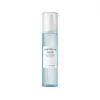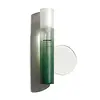What's inside
What's inside
 Key Ingredients
Key Ingredients

 Benefits
Benefits

 Concerns
Concerns

No concerns
 Ingredients Side-by-side
Ingredients Side-by-side

Camellia Sinensis Leaf Water
MaskingWater
Skin Conditioning1,2-Hexanediol
Skin ConditioningIsopentyldiol
HumectantCentella Asiatica Extract 0.3%
CleansingCordyceps Militaris Extract
Skin ConditioningHibiscus Esculentus Fruit Extract
Skin ConditioningButylene Glycol
HumectantMethylpropanediol
SolventBetaine
HumectantXylitol
HumectantSodium Hyaluronate
HumectantHydrolyzed Hyaluronic Acid
HumectantHyaluronic Acid
HumectantPolyglyceryl-10 Oleate
Skin ConditioningPolyglyceryl-10 Myristate
Skin ConditioningPentylene Glycol
Skin ConditioningPolyglyceryl-6 Dioleate
EmulsifyingPyrus Communis Fruit Extract
Skin ConditioningAdenosine
Skin ConditioningRosa Damascena Flower Water
MaskingPolyglyceryl-4 Laurate
EmulsifyingEthylhexylglycerin
Skin ConditioningCucumis Melo Fruit Extract
Skin ConditioningCitric Acid
BufferingIris Florentina Root Extract
MaskingSodium Phytate
Hedera Helix Leaf/Stem Extract
AntimicrobialPolyglutamic Acid
Skin ConditioningGalactomyces Ferment Filtrate
HumectantArtemisia Princeps Leaf Extract
Skin ConditioningGlycerin
HumectantCaprylic/Capric Triglyceride
MaskingHydrogenated Lecithin
EmulsifyingCeramide NP
Skin ConditioningCamellia Sinensis Leaf Water, Water, 1,2-Hexanediol, Isopentyldiol, Centella Asiatica Extract 0.3%, Cordyceps Militaris Extract, Hibiscus Esculentus Fruit Extract, Butylene Glycol, Methylpropanediol, Betaine, Xylitol, Sodium Hyaluronate, Hydrolyzed Hyaluronic Acid, Hyaluronic Acid, Polyglyceryl-10 Oleate, Polyglyceryl-10 Myristate, Pentylene Glycol, Polyglyceryl-6 Dioleate, Pyrus Communis Fruit Extract, Adenosine, Rosa Damascena Flower Water, Polyglyceryl-4 Laurate, Ethylhexylglycerin, Cucumis Melo Fruit Extract, Citric Acid, Iris Florentina Root Extract, Sodium Phytate, Hedera Helix Leaf/Stem Extract, Polyglutamic Acid, Galactomyces Ferment Filtrate, Artemisia Princeps Leaf Extract, Glycerin, Caprylic/Capric Triglyceride, Hydrogenated Lecithin, Ceramide NP
Water
Skin ConditioningGlycerin
HumectantBetaine
HumectantPropanediol
Solvent1,2-Hexanediol
Skin ConditioningPhyllostachys Nigra Leaf Extract
Skin ConditioningPhyllostachys Pubescens Shoot Bark Extract
Skin ConditioningBambusa Vulgaris Shoot Extract
AntioxidantSodium Phytate
Alcohol
AntimicrobialBeta-Glucan
Skin ConditioningAspergillus Ferment
Skin ConditioningZanthoxylum Piperitum Fruit Extract
Skin ConditioningPulsatilla Koreana Extract
Skin ConditioningUsnea Barbata Extract
Polyglyceryl-10 Laurate
Skin ConditioningPolyglyceryl-10 Myristate
Skin ConditioningParfum
MaskingWater, Glycerin, Betaine, Propanediol, 1,2-Hexanediol, Phyllostachys Nigra Leaf Extract, Phyllostachys Pubescens Shoot Bark Extract, Bambusa Vulgaris Shoot Extract, Sodium Phytate, Alcohol, Beta-Glucan, Aspergillus Ferment, Zanthoxylum Piperitum Fruit Extract, Pulsatilla Koreana Extract, Usnea Barbata Extract, Polyglyceryl-10 Laurate, Polyglyceryl-10 Myristate, Parfum
 Reviews
Reviews

Ingredients Explained
These ingredients are found in both products.
Ingredients higher up in an ingredient list are typically present in a larger amount.
1,2-Hexanediol is a synthetic liquid and another multi-functional powerhouse.
It is a:
- Humectant, drawing moisture into the skin
- Emollient, helping to soften skin
- Solvent, dispersing and stabilizing formulas
- Preservative booster, enhancing the antimicrobial activity of other preservatives
Betaine is a common humectant (a substance that promotes retention of moisture). It's known to be gentle on the skin and can help balance hydration.
This ingredient is best for improving hydration and soothing irritated skin. Studies also show it helps even out skin tone.
Fun fact: Betaine is naturally created in the skin and body. The kind found within cosmetic products can be either plant-derived or synthetic.
Another name for betaine is trimethylglycine.
Learn more about BetaineGlycerin is already naturally found in your skin. It helps moisturize and protect your skin.
A study from 2016 found glycerin to be more effective as a humectant than AHAs and hyaluronic acid.
As a humectant, it helps the skin stay hydrated by pulling moisture to your skin. The low molecular weight of glycerin allows it to pull moisture into the deeper layers of your skin.
Hydrated skin improves your skin barrier; Your skin barrier helps protect against irritants and bacteria.
Glycerin has also been found to have antimicrobial and antiviral properties. Due to these properties, glycerin is often used in wound and burn treatments.
In cosmetics, glycerin is usually derived from plants such as soybean or palm. However, it can also be sourced from animals, such as tallow or animal fat.
This ingredient is organic, colorless, odorless, and non-toxic.
Glycerin is the name for this ingredient in American English. British English uses Glycerol/Glycerine.
Learn more about GlycerinPolyglyceryl-10 Myristate isn't fungal acne safe.
Sodium Phytate is the synthetic salt form of phytic acid. Phytic acid is an antioxidant and can be found in plant seeds.
Sodium Phytate is a chelating agent. Chelating agents help prevent metals from binding to water. This helps stabilize the ingredients and the product.
Water. It's the most common cosmetic ingredient of all. You'll usually see it at the top of ingredient lists, meaning that it makes up the largest part of the product.
So why is it so popular? Water most often acts as a solvent - this means that it helps dissolve other ingredients into the formulation.
You'll also recognize water as that liquid we all need to stay alive. If you see this, drink a glass of water. Stay hydrated!
Learn more about Water